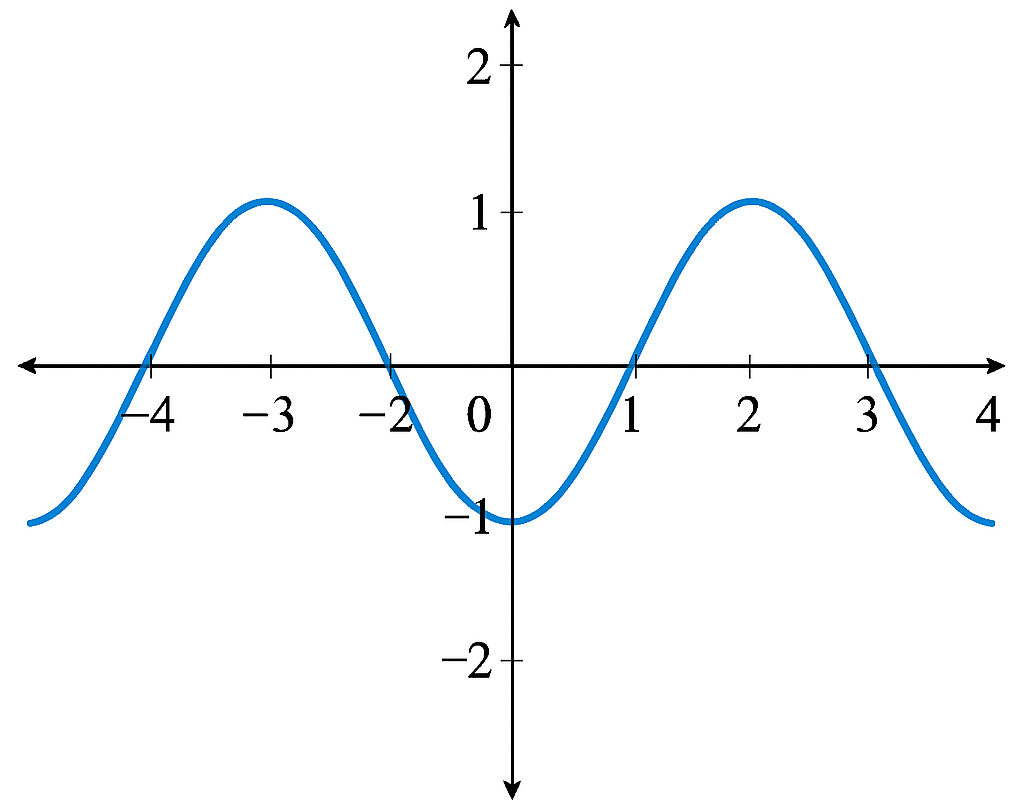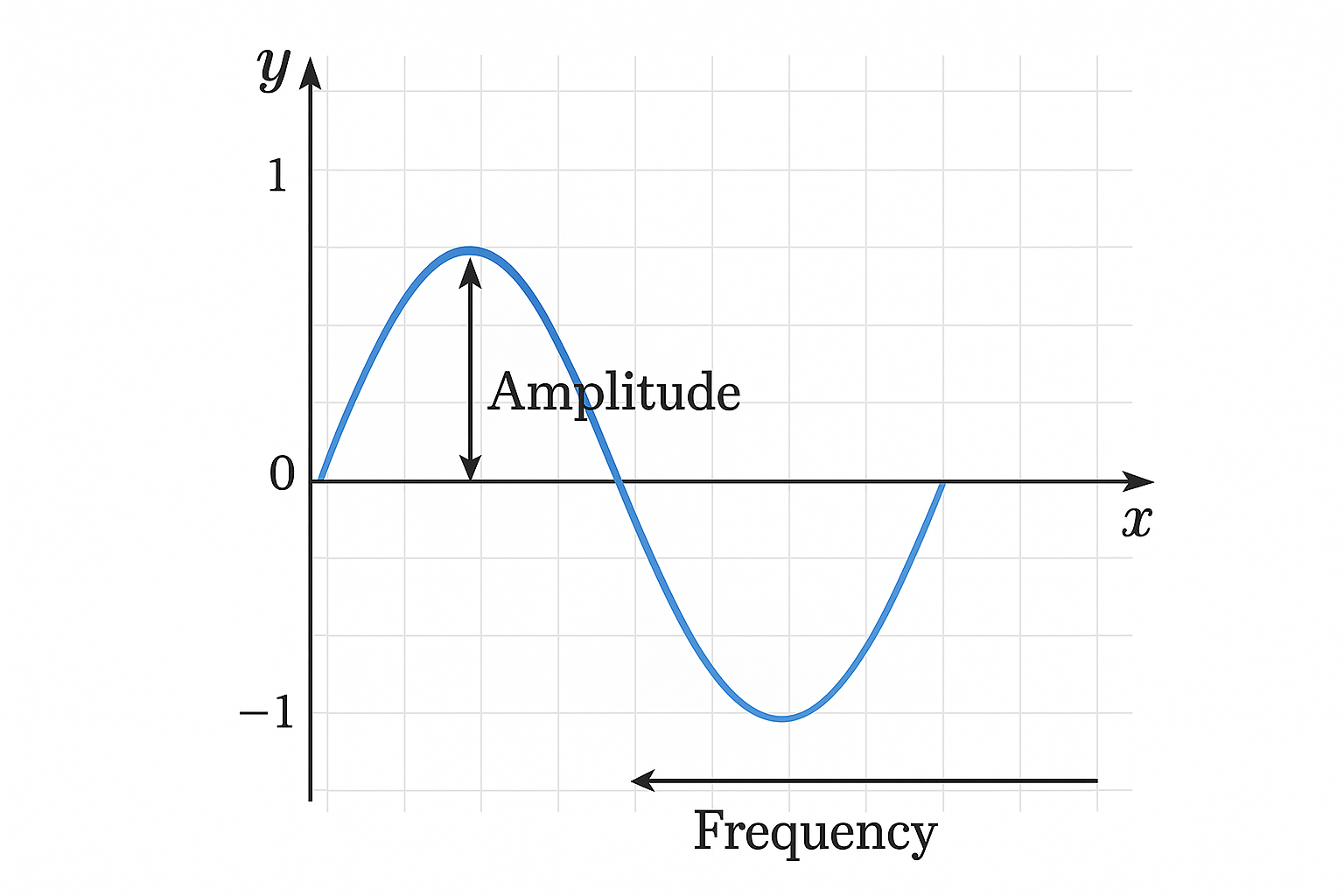Understanding Periodic Functions | Maths Explanation for C++ Kids
In this tutorial, we'll learn how to use C++ periodic functions to create animations of sine and cosine waves. Understanding periodic functions is an essential part of senior secondary mathematics, and C++ offers a fun, visual way to explore them.
What Are Periodic Functions? | Maths Explanation for C++ Kids
A periodic function repeats its values at regular intervals. Common examples include the sine and cosine functions. In mathematics, these functions are essential for modeling waves and oscillations. In C++, we can easily simulate periodic functions like the sine and cosine curves using simple trigonometric equations. We'll represent these functions graphically using C++ Window Frame.

Properties of Periodic Functions: Period, Amplitude & Frequency | Maths Explanation for C++ Kids
Every periodic function has three key properties:
- Amplitude - the maximum height of the wave from its central position.
- Period - the horizontal distance over which the function repeats.
- Frequency - the number of complete cycles per unit interval.

Understanding these properties helps in analyzing periodic function graphs and predicting their patterns.
How to Simulate Sinusoidal Curves in C++
Periodic functions produce an infinite order of sinusoidal curves.
The sine function has the general form
y = a × sin(θ) + c;
and the cosine function has the general form
y = a × cos(θ) + c;
where θ is angle in radians and
a is an arbitrary constant that heightens
the curve.
Animating a Periodic Wave Using C++
We can animate a sine or cosine wave in C++ using the C++ Window Frame. By incrementing θ continuously and computing y using the trigonometric function, a dot or object moves along a periodic path that represents the wave. The angle θ is in radians, and you can use any c value that gives a satisfactory amplitude.
Create a new C++ project;
call it Dymetric.
Create 2 new C++ class files;
Call them Facet and PeriodicFunction.
Type out the adjoining C++ code for animating an image body through the path of a sine / cosine curve.
This code draws one complete periodic sine wave, allowing students to observe how the function repeats its pattern.
Exploring the Cosine Function in C++
Similar to the sine wave, we can animate the cosine curve using C++ trigonometric animation techniques.
Note: To create a cosine wave animation, simply replace Math.sin with Math.cos.
Key Takeaways on Periodic Wave Animation in C++
In this tutorial, you've learned:
- Periodic functions repeat after a fixed interval called the period
- They are fundamental in trigonometry, wave analysis, and C++ visualizations.
- Use the C++ graphing example to explore amplitude, period, and phase shift interactively.
By blending mathematics and coding, students can better visualize abstract periodic concepts and prepare for advanced studies in both fields.
FAQs: Periodic Functions and C++
What is a periodic function in C++?
A periodic function repeats its values over intervals, such as sine or cosine, and can be represented graphically using C++ Window Frame and trigonometric functions.
How do you animate a sine wave using C++?
Use the Math.sin() function with the C++ Window Frame to simulate oscillations.
Can I animate objects along a periodic path in C++?
Yes! You can use sine and cosine to calculate x and y positions for smooth, looping motion.
Applications of Periodic Functions in C++ Programming and STEM Education
Periodic functions are used in physics, sound waves, and even game development. By coding these in C++, students can visualize maths periodic functions dynamically.
Understanding periodic functions in C++ helps students visualize mathematical concepts such as oscillation, waves, and harmonic motion. These concepts apply in fields like physics, sound processing, and even game development, where trigonometric animation brings realism to motion.
Summary: Periodic vs Aperiodic Functions | Maths Explanation for C++ Kids
Periodic functions in C++ are useful for simulating waves, oscillations, and rhythmic motion. Understanding the period, amplitude, and frequency of these functions helps you create dynamic visuals, animations, and simulations. Whether you're studying math periodic functions or applying them in web development, these tools make complex periodic behavior easier to model and visualize.
Not every function repeats itself.
- A periodic function has a consistent cycle (e.g., sine, cosine).
- An aperiodic function does not repeat (e.g., linear or exponential functions).
Understanding this difference helps students see why periodic motion is predictable - an important skill in physics, sound, and electrical circuits.
Mastering periodic functions prepares students for advanced trigonometry and real-life applications such as sound waves and electrical signals. Practice with our periodic function examples and questions to strengthen your understanding.
So! C++ Fun Practice Exercise - Animate along Periodic Wave
As a fun practice exercise, try modifying parameters like amplitude or frequency to explore how periodic functions in C++ behave. You can also:
- Plot f(θ) = a * cos(θ) + c
- Plot f(θ) = a * sin(2θ) + c
- Write a C++ function that combines sine and cosine
This will be a great way to connect mathematics and programming, and help you understand more about C++ animations and periodic functions.
C++ Periodic Wave Dymetric Window Code Stub
C++ Periodic Wave Canvas Frame and Button Controls - Header File
class Facet
{
public:
Facet(HWND, int, int);
virtual ~Facet();
bool decorateButton(WPARAM, LPARAM);
bool actionPerformed(HWND, WPARAM, LPARAM);
void informPaint();
};
C++ Periodic Wave Canvas Frame and Button Controls - Class File
#include "Facet.h"
#include "PeriodicFunction.h"
PeriodicFunction* pf_track;
/*
* Our custom class that interfaces between the parent window
* and the subsequent daemonstrator classes
*/
Facet::Facet(HWND hWnd, int window_width, int window_height)
{
pf_track = new PeriodicFunction(hWnd, window_width, window_height);
}
/*
* This guy decorates buttons with colour and title text
*/
bool Facet::decorateButton(WPARAM wParam, LPARAM lParam) {
// button glide calling
if (wParam == 12321)
{
LPDRAWITEMSTRUCT lpDIS = (LPDRAWITEMSTRUCT)lParam;
SetDCBrushColor(lpDIS->hDC, RGB(255, 192, 203));
SelectObject(lpDIS->hDC, GetStockObject(DC_BRUSH));
RECT rect = { 0 };
rect.left = lpDIS->rcItem.left;
rect.right = lpDIS->rcItem.right;
rect.top = lpDIS->rcItem.top;
rect.bottom = lpDIS->rcItem.bottom;
RoundRect(lpDIS->hDC, rect.left, rect.top, rect.right, rect.bottom, 50, 50);
// button text
DrawText(lpDIS->hDC, TEXT("MOVE"), -1, &rect, DT_SINGLELINE | DT_CENTER | DT_VCENTER);
return TRUE;
}
return FALSE;
}
/*
* Call the target class' draw method
*/
void Facet::informPaint() {
pf_track->paint();
}
/*
* Say there is more than a single push button,
* this guy picks out the correct button that got clicked
* and calls the corresponding apt function
*/
bool Facet::actionPerformed(HWND hWnd, WPARAM wParam, LPARAM lParam)
{
switch (LOWORD(wParam))
{
case 12321:
pf_track->moveSinusoidal();
return TRUE;
default:
return FALSE;
}
}
Facet::~Facet()
{
delete pf_track;
}
C++ Animation Code for Periodic Function - Header File
#define aWIDTH 10
#define aHEIGHT 10
#define PI 3.1415926535897932384626433832795
class PeriodicFunction
{
public:
PeriodicFunction(HWND, int, int);
virtual ~PeriodicFunction();
void paint();
void moveSinusoidal();
protected:
HWND hWindow;
HDC hdc;
int window_width;
int window_height;
COLORREF ball_colour;
int theta;
int a; // constant
int y;
HPEN ball_pen;
HBRUSH ball_brush;
};
C++ Animation Code for Periodic Function - Class File
#include "PeriodicFunction.h"
#include <math.h>
PeriodicFunction::PeriodicFunction(HWND hWnd, int window_width, int window_height)
{
hWindow = hWnd; // save away window handle
this->window_width = window_width; // save away window width
this->window_height = window_height; // save away window width
ball_colour = RGB(255, 0, 0);
theta = 0;
a = 100; // constant
// convert theta from degree to radians (work in a little translate for y)
y = (int)round(a * sin(theta * (long double)PI / 180)) + int(window_height / 2);
// Pen and brush for travelling ball
ball_pen = CreatePen(PS_SOLID, 1, RGB(0, 0, 0));
ball_brush = CreateSolidBrush(ball_colour);
hdc = GetDC(hWindow);
SelectObject(hdc, ball_pen); // select ball pen colour
SelectObject(hdc, ball_brush); // select ball brush colour
// draw a second demarcation line
MoveToEx(hdc, 0, 80, NULL);
LineTo(hdc, window_width, 80);
// draw x-axis
MoveToEx(hdc, 0, int(window_height/2 + aHEIGHT/2), NULL);
LineTo(hdc, window_width, int(window_height/2 + aHEIGHT/2));
}
/*
* draws the ball/circle using the apt color
*/
void PeriodicFunction::paint() {
// draw a dot
Ellipse(hdc, theta, y, theta + aWIDTH, y + aHEIGHT);
}
void PeriodicFunction::moveSinusoidal() {
// condition for continuing motion
while (theta + aWIDTH < window_width) {
// work in a little translate for y
y = (int)round(a * sin(theta * (long double)PI / 180)) + int(window_height / 2);
paint();
theta += 15;
// introduce a delay between renderings
Sleep(50);
}
}
PeriodicFunction::~PeriodicFunction()
{
DeleteObject(ball_pen);
DeleteObject(ball_brush);
ReleaseDC(hWindow, hdc);
}
